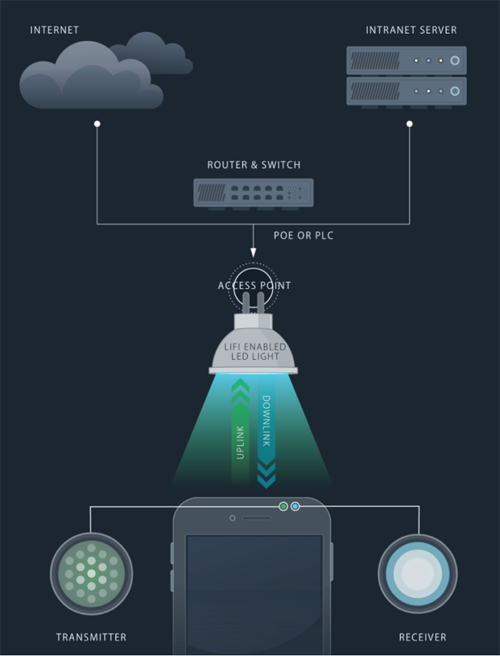

The concept of Li-Fi has been proposed as early as ten years ago. Li-Fi is a visible light wireless communication technology different from Wi-Fi, which can provide Internet connection with the help of ordinary light bulbs.
However, ten years later, Li-Fi still has not replicated the success of Wi-Fi technology in the field of wireless communication, let alone replaced Wi-Fi.
Wireless Communication Technology
Once, Li-Fi also had high hopes.
Previously, many Li-Fi products have been launched.
In 2018, Oledcom released a Li-Fi product, the MyLi-Fi desk lamp router, which enables Internet access through the light of the desk lamp. This is the first visible light communication desk lamp product in the world that is open to the public. MyLiFi is designed in the shape of a desk lamp, which can be turned on and off through the APP, but its function is not limited to smart lights, but can also be used as a route for the transmission network, which can receive the network through a USB interface light receiver, as long as the light in MyLiFi Network connection can be achieved within the range of irradiation. But its download speed can not be compared with 2.4GHz Wi-Fi network.
lifi wireless communication technology
In the same year, the American company VLNComm launched the first Li-Fi LED lighting panel - LumiNex. The LumiNex lighting panel can provide a download speed of 108Mbps, and the network coverage is up to 48 square meters. If equipped with general industry-standard white LEDs, it can support 15 users to surf the Internet.
lifi smart light
In 2021, the U.S. military stationed in Europe and Africa joined pureLi-Fi to build the world's first large-scale Li-Fi system, KiteFin.
......
However, until today, there is still no smartphone that supports Li-Fi technology, and Li-Fi has not been successfully commercialized.
The difference between Wi-Fi and Li-Fi wireless communication technology
The biggest difference between them is that Li-Fi uses light and transmits data by adjusting the frequency of light, while Wi-Fi uses radio and transmits data through antennas.
Li-Fi technology can use existing LED equipment to implant a small chip or module on the light bulb to turn it into a Li-Fi AP. Fi devices can access the network within range.
1. Wireless transmission distance
Li-Fi transmits data by adjusting the frequency of light. Light transmission faces huge challenges. We know very well that, compared with radio, light cannot penetrate obstacles. Li-Fi using LED light sources can only transmit at a distance of about 10 meters. Wi-Fi is free of obstacles. It can cover more than 100 meters in the scene.
2. Wireless transmission speed
The theoretical speed of Li-Fi is as high as 224Gbps, and the current Wi-Fi 6E is only 9.6Gbps. It seems that the transmission speed of Li-Fi is much higher than that of Wi-Fi. At the same time, Li-Fi can avoid electromagnetic wave interference through optical transmission, and achieve high-speed, high-quality, and low-latency network transmission.
3. IoT application scenarios
The reason why Wi-Fi is the most popular communication technology lies in its applicability and various practical scenarios. More than 90% of network environments can use Wi-Fi for data transmission. The inapplicable scenarios are mainly for radio signal comparison. Sensitive environments, such as airports, military bases, etc. Because it uses light transmission, the coverage of Li-Fi will be affected by various obstacles. Once the light source is cut off, the signal will disappear, so the application scenario is very limited.
Challenges facing Li-Fi
"Success is also light and failure is also light".
Li-Fi technology uses visible light to achieve communication. First, visible light cannot penetrate obstacles, so it is easily restricted by obstacles; secondly, once the light source disappears, the network signal will be interrupted. For example, if you put your mobile phone in your pocket, you cannot touch the light. signal, the Li-Fi signal will be interrupted immediately. These may be the reasons why Li-Fi technology has not been popularized.
Compared with other wireless technologies, Li-Fi's current industry chain is dominated by research institutions. Although many LED manufacturers are actively participating, they still lack the support of terminal manufacturers and chip manufacturers, and lack the support of an industrial ecosystem. Many Li-Fi companies no longer exist. Li-Fi is not necessarily a replacement for Wi-Fi or 5G. The existence of Li-Fi is more of a supplement to Wi-Fi transmission scenarios. With the coexistence of wireless technologies, Li-Fi will face the possibility of being eliminated from the market.







